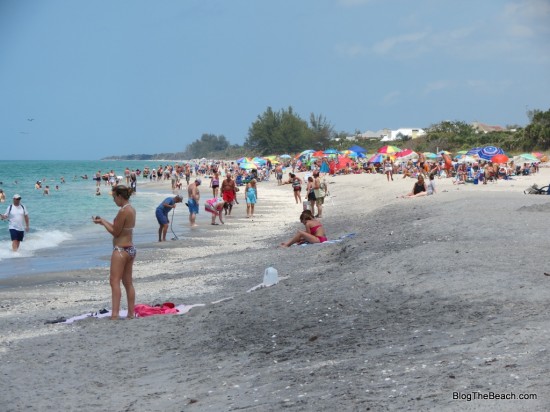Most Florida islands and beaches are very low crime areas. Some have nearly zero crime. I’ve always felt safer at the beach than in any other location. Still, property theft, inappropriate behavior and physical violence can happen at the beach, so you need to know how to avoid it.
Property Theft
Most crime at the beach involves theft of property. Thieves know that beach visitors leave valuable items in their vehicles: cameras, wallets, items they’ve purchased while on vacation, etc. They also know that people leave valuables on their beach towel while they go swimming. Property theft crimes happen on most beaches from time to time and are fairly easy to guard against. Lock valuables out of sight in your car trunk and don’t leave anything on your beach towel that you would not be willing to lose.
Keep your hotel room locked. That means being sure the first floor windows are locked as well. I’m always amazed at how many first floor rooms I rent where all the windows are unlocked when I check in. Don’t leave your valuables laying around in your hotel room when you leave. Pack them away, out of sight.
Physical Violence at the Beach
Youthful crowds + alcohol = fights. And youthful crowds + gang activity = violence. This is nothing new, but a lot of folks think life is so laid-back at the beach that riots and crowd violence don’t happen. Large beach crowds near dense urban areas can lead to large fights that involve hundreds of people. Panama City Beach, Daytona Beach, Clearwater Beach, Ft. Lauderdale Beach and South Beach Miami all have the ingredients conducive to out-of-control crowds. This can get even worse during Spring Break.
Recently fights broke out simultaneously at Ft. Lauderdale Beach at Las Olas and on Miami’s South Beach. Hundreds of people were involved and heavy police involvement was required to break up the fights and arrest the instigators. See the video below shot by a cell phone.
Some people blame this sort of mayhem on social media, but a quick internet search turned up Ft. Lauderdale Beach brawl stories from as far back as 1973
Both Clearwater Beach and Panama City Beach have alcohol fueled beach brawls from time to time during Spring Break.
One of the worst beach riots happened in Daytona Beach back in 1956. Today’s militarized law enforcement is equipped to deal with unruly crowds, but things can still boil out-of-control very quickly and can involve hundreds of people.
You don’t want to be at the beach in these kinds of crowds. If you want to spend Spring Break at the beach, pick a more laid-back beach town like Cocoa Beach, Siesta Key, or Saint Pete Beach. I’d recommend avoiding holiday weekends at any of the problem beaches.
Small beach towns are not without sporadic problems. One of the smallest and most relaxed beach towns anywhere in Florida, Bradenton Beach, suffered for years from holiday weekend gang violence at Coquina Public Beach which came to a head with a gang-related shooting on the beach on Easter Weekend 2007 even in the presence of heavy law enforcement. Unlike some of the larger towns which might just accept this a part of being overcrowded and overdeveloped, Bradenton Beach and Manatee County met the problem head-on and completely reconfigured the beach access infrastructure at Coquina Beach to discourage gang-style “cruising” in the parking areas. Today my reliable sources tell me the problem has been eliminated. However, you still won’t find me there on holiday weekends.
Sex Crimes at the Beach
Women should never walk alone on the beach after dark and should generally avoid being alone on remote beaches or parking areas at any time of day. Violent sex crimes are not common on Florida beaches, but they do occur. And so as not to alarm visitors, they are not well publicized.
I am not familiar with the goings-on at all of the beaches in Florida, but I do keep fairly close tabs on west central and southwest Florida beaches. Most encounters on the beach that might be construed as sexual are nothing more than a person minding their own business and being discreetly nude on a quiet part of the beach. Other times people may be seen soliciting sexual encounters on the beach or exposing themselves in a lewd manner.
The best way to avoid encountering nude people on the beach is to learn which beaches attract nudists. Canaveral National Seashore’s Apollo Beach and Playalinda Beach, Miami’s Haulover Beach, the remote reaches of Sanibel’s Bowman’s Beach are typical examples where nudity may be encountered. Haulover Beach is the only beach where public nudity is legal.
Simply being nude on the beach is not a crime (though it is a misdemeanor), but lewd and nude is a crime. Some beaches have developed a reputation for attracting gay males trying to hook up with other gay males. Caspersen Beach in Venice, Bunche Beach in Ft. Myers, and Sarasota’s North Lido Beach come to mind as gay hook up areas. Authorities generally make an ongoing effort to discourage this behavior.
Safest Beaches
The safest beaches are the ones most difficult to get to. The Palm Island group with Don Pedro and Little Gasparilla Island is probably one of the safest. Longboat Key, Siesta Key, Marco Island, Destin, Seaside, Flagler, Indialantic, Melbourne–beaches that tend not to attract huge crowds of young people fueled with a mix of alcohol and hormones–are also beaches with a low chance of encountering crime.
Use common sense, stay alert and be aware that everyone in Florida is not here on vacation.
More Tips to Avoid Crime and Stay Safe at the Beach
- When you arrive at the beach, parking may be scarce and you may have to park in the far reaches of the lot. If you are staying for sunset you may find yourself returning to your car after dark and have to walk through a dark and deserted parking lot to reach your car. Try to anticipate this situation and move your car closer to the beach or closer to the lighted beach facilities when the crowd thins and before it gets too dark.
- Always make note of where exactly on the beach you are located, in case you need to call for help. Most beaches have some type of system for referring to your geographic location either by street number markings near a boardwalk or by numbered or colored lifeguard towers or by a sign indicating the beach access name or number. Before going out onto the beach, take a moment to stop and read all the “warning” signs located near the beach trail.
- You can feel comfortable on crowded beaches where there is a good mix of young people, families and seniors, even when the crowd is very heavy. Think twice about a beach scene where 90 percent of people on the beach are under 30 and are drinking alcohol. Especially if there are a lot of them.
- Most major public beaches have a visible law-enforcement presence. If you are concerned, locate yourself near a lifeguard tower or near law enforcement. Daytona Beach, Clearwater Beach and Siesta Key Public Beach, as examples that quickly come to mind, all have very active and visible law enforcement personnel on the beach and they do a very good job of keeping things civil.
- If you are on a beach where driving is permitted, be sure you and your children stay well clear of the marked driving lanes. Regrettably, someone gets run over almost every year on the beach and sometimes it’s the beach patrol that runs them over.





